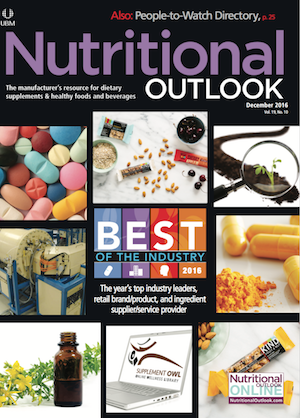Nutritional Outlook's 2016 Best of the Industry, Industry Leader: Botanical Adulterants Program
The program’s newest educational tools keep stakeholders up to date on botanical adulteration.
Photo © Shutterstock.com/Michael Nivelet

Staying a step ahead of fraud can seem nearly impossible at times, given how adroitly cybercriminals and adulterers find new ways-overnight, it seems-to skirt existing detection capabilities. Luckily, there are those devoted to developing tools to help fight adulteration. In the herbal products industry, the Botanical Adulterants Program is one of those champions. Developed five years ago by three U.S.-based nonprofit organizations-the American Botanical Council (ABC; Austin, TX), the American Herbal Pharmacopoeia (AHP; Scotts Valley, CA), and the University of Mississippi’s National Center for Natural Products Research (NCNPR; University, MS)-the ABC-AHP-NCNPR Botanical Adulterants Program is dedicated to spreading awareness and education about how herbs, herbal extracts, essential oils, and other plant-derived ingredients are being adulterated, either deliberately for financial gain or accidentally due to poor quality control.
Over the past five years, the Botanical Adulterants Program has evolved into a “long-term, multiparty coalition” of herbal experts supported by more than 175 U.S. and international underwriters and endorsers. Participants include universities, third-party analytical labs, government agencies, trade associations, and industry companies. Their shared goal is to help prevent botanical adulteration by determining both the scope of adulteration happening in U.S. and global markets, as well as determining whether appropriate tools exist to detect adulteration-and then spreading the word.
The program’s educational arsenal includes the comprehensive Botanical Adulteration Reports published in ABC’s prestigious, peer-reviewed scientific journal, HerbalGram; a Botanical Adulterants Monitor newsletter; plus peer-reviewed Laboratory Guidance Documents, which are developed to help identify the most suitable analytical methods for testing botanicals for adulteration.
Anyone who has read one of the extensive Botanical Adulteration Reports in HerbalGram can attest to the value of these lengthy reports, each focusing in on a specific botanical ingredient and peer-reviewed by experts in the field. This spring, the program added something new: Botanical Adulterants Bulletins. These concise (but still information-packed) reviews of ingredient-specific botanical adulteration are not as in-depth as full-scale Botanical Adulteration Reports, but are still jam-packed with crucial information. Together, “the full papers and the Bulletins provide the background and available data on herbal ingredients where quality problems have been confirmed, give a fairly broad overview of the plant species, and include data on cultivation, harvest and market size, known adulterants, frequency of adulteration (if such data is available), possible therapeutic issues using the adulterating species, and a short review of analytical approaches to detect the adulterant,” says Stefan Gafner, PhD, ABC’s chief science officer and technical director of the Botanical Adulterants Program and editor of the Botanical Adulterants Monitor.
Timeliness, as we know, is key when it comes to fighting adulteration, particularly for certain ingredients. “For ingredients where there are many adulterant options, the adulteration landscape changes frequently,” Gafner says. “An example is bilberry extract, where a number of fruit extracts which contain anthocyanins, the blue pigments giving bilberry its color, are used to fool the analytical test methods for bilberry and for which new adulterants are reported almost on a yearly basis.”
And therein lies the beauty of the Bulletins: because they are concise and in digital form, they can be updated more quickly while still retaining the high quality intrinsic to the Botanical Adulterants Program. “The Bulletins are shorter reviews on current issues of herbal ingredient adulteration, which can be released in a more timely manner,” Gafner says. In a press release, Mark Blumenthal, ABC’s founder and executive director, called the Bulletins “a more rapid means of confirming suspected and/or alleged adulteration.”
So far, the program has published six Bulletins (on bilberry, grapeseed, skullcap, goldenseal, black cohosh, and arnica), with two more set to be published soon on saw palmetto and St. John’s wort and plans for upcoming Bulletins on ashwagandha, ginkgo, and rhodiola.
The need for the Botanical Adulterants Program has never been more urgent, as the herbal-supplements industry is increasingly under scrutiny by the public and regulators. As the Botanical Adulterants Program and its esteemed participants continue the crusade against herbal adulteration, their positive effects are being felt not only within the industry but also where it matters most-consumer health and safety.
Other 2016 winners:
Nutritional Outlook's 2016 Best of the Industry, Industry Leader: Council for Responsible Nutrition
Nutritional Outlook's 2016 Best of the Industry, Ingredient Supplier/Service Provider: Sabinsa Corp.
Nutritional Outlook's 2016 Best of the Industry, Retail Brand/Product: KIND
Also read:
New Botanical Adulterants Bulletins from American Botanical Council Dive Deep into Herbal Fraud
ABC Investigates Black Cohosh Adulteration in Latest Bulletin
Dietary Supplements: New Testing Tools to Catch Botanical Adulteration






















